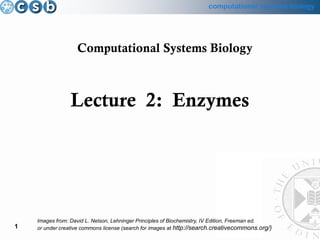
cours élémentaire sur les protéines et enzymes
- 1. computational systems biology 1 Lecture 2: Enzymes Computational Systems Biology Images from: David L. Nelson, Lehninger Principles of Biochemistry, IV Edition, Freeman ed. or under creative commons license (search for images at http://search.creativecommons.org/)
- 2. computational systems biology 2 Suggested reading Book: David L. Nelson, Lehninger - Principles of Biochemistry, 4th Edition (or 3rd Edition), W. H. Freeman ed. http://bcs.whfreeman.com/lehninger/ • Enzymes – Lehninger Chapter 1.3 – Enzymes promote sequences of chemical reactions (pp 26-27) – Lehninger Chapter 3 – Amino acids, peptides and proteins (pp 75-89, for general reference) – Lehninger Chapter 6 – Enzymes (pp 190-200, for general reference) (page numbers refer to the 4th edition)
- 3. computational systems biology 3 Summary • What is an enzyme • Enzymes 3D structures • How enzyme work: enzymatic catalysis • The Enzyme Classification (EC) codes
- 4. computational systems biology 4 Enzymes are proteins • In general, a protein is a chain of amino acids (aa) covalently linked (when the chain is short ~5-10 aa, the protein is often called oligopeptide/polypeptide or simply peptide) • Thousands of different proteins are built with the same ubiquitous set of 20 amino acids (the protein “alphabet”) • Some proteins have structural roles (e.g. actin in the muscles), other have catalytic (chemical-reaction-making) activity and are called enzymes • A polypeptide with 4 amino acids (Ala-Glu-Gly- Lys) • The electrically charged groups are shown in red • In a longer protein the electrically charged lateral groups can line a pocket of the enzyme 3D structure to generate an active reaction site (see following slides)
- 5. computational systems biology 5 20 amino acids The 1 letter and 3 letters codes
- 6. computational systems biology 6 Proteins come in all shapes and sizes
- 7. computational systems biology 7 Enzymes 3D structure • Enzymes are proteins and their activities depends on the 3D structure of the amino acids that compose them (note: also some RNAs have catalytic activity but they won’t be covered in this course) Images from: David L. Nelson, Lehninger Principles of Biochemistry, IV Edition, W. H. Freeman ed.
- 8. computational systems biology 8 PDB - Database of protein structures • PDB (RCSB Protein Data Bank) • http://www.rcsb.org/pdb/home/home.do • How is the data collected? Every 3D protein sequence has to be deposited in PDB before publication in reviewed journals
- 9. computational systems biology 9 • Common secondary structures are alpha helixes (here in different graphical representations) • And beta sheets Secondary structure
- 10. computational systems biology 10 Structural domains • Recurring motifs (here the beta-alpha-beta loop) are the basis for protein structural classification • Enzymes with similar sequences and structural domains / motifs are classified in the same protein family
- 11. computational systems biology 11 Interpro: the protein families database • InterPro is a database of protein families, domains and functional sites • Identifiable features found in known proteins can also be scanned against unknown protein sequences • (here an example of domain common to enzymes that use iron as cofactor to cut an hydrogen atom from an alcool). InterPro incorporates data from other databases
- 12. computational systems biology 12 • IMPORTANT: enzymes do NOT and cannot affect the equilibrium / free energy difference of a reaction • Enzymes enhance the reaction rates (molecules produced per second) by lowering the activation energy of the transition state ΔG‡ cat How enzymes work
- 13. computational systems biology 13 Images from: David L. Nelson, Lehninger Principles of Biochemistry, IV Edition, W. H. Freeman ed. Transition state energy changed by an enzyme (in blue)
- 14. computational systems biology 14 Images from: David L. Nelson, Lehninger Principles of Biochemistry, IV Edition, W. H. Freeman ed. The enzyme action on the transition state
- 15. computational systems biology 15 From: David L. Nelson, Lehninger Principles of Biochemistry, IV Edition, W. H. Freeman ed. The red molecule is the substrate, the active site appears painted in red The enzyme active site
- 16. computational systems biology 16 Enzyme: The surface inside the active site Images from: David L. Nelson, Lehninger Principles of Biochemistry, IV Edition, W. H. Freeman ed. You can see a flash demo of this enzymatic reaction on: http://bcs.whfreeman.com/lehninger/ clicking on Chapter 6: Enzymes mechanism animation fig 6.21 mechanism for chymotrypsin
- 17. computational systems biology 17 E.C. Enzyme nomenclature • Enzymes are named depending on the reaction they catalyse. • Examples of enzyme groups are: • EC 1 - Oxidoreductases • EC 2 - Transferases • EC 3 - Hydrolases • EC 4 - Lyases • EC 5 - Isomerases • EC 6 - Ligases
- 18. computational systems biology 18 An example of E.C. enzyme nomenclature EC 3. Hydrolases EC 3.1 Hydrolases Acting on Ester Bonds • EC 3.1.3 Phosphoric Monoester Hydrolases – EC 3.1.3.1 alkaline phosphatase – EC 3.1.3.2 acid phosphatase – EC 3.1.3.3 phosphoserine phosphatase – EC 3.1.3.4 phosphatidate phosphatase – EC 3.1.3.5 5'-nucleotidase – EC 3.1.3.6 3'-nucleotidase – EC 3.1.3.7 3'(2'),5'-bisphosphate nucleotidase – EC 3.1.3.8 3-phytase – EC 3.1.3.9 glucose-6-phosphatase – EC 3.1.3.10 glucose-1-phosphatase – EC 3.1.3.11 fructose-bisphosphatase
- 19. computational systems biology 19 Example: fructose-bisphosphatase EC 3.1.3.11 From the IUBMB (International Union of Biochemistry and Molecular Biology) web site: http://www.chem.qmul.ac.uk/iubmb/enzyme/ one can reach a record for the enzyme: EC 3.1.3.11 (fructose-bisphosphatase): http://www.chem.qmul.ac.uk/iubmb/enzyme/EC3/1/3/11.ht ml The site also contains the reaction diagram shown here: http://www.chem.qmul.ac.uk/iubmb/enzyme/reaction/polys acc/Calvin2.html The reaction involves the hydrolysis (separation) of a phosphate group here represented by Pi The “P” representing the phosphate group that appears on the top region of the D-fructose-1,6-biphosphate substrate molecule has disappeared after the reaction, and the product is now called D- fructose 6-phospate (the phosphate group in position 1 is no more there).